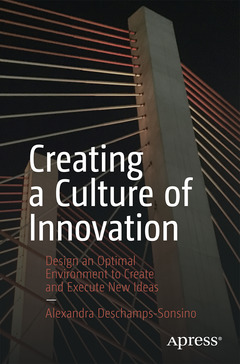Creating a Culture of Innovation, 1st ed. Design an Optimal Environment to Create and Execute New Ideas
Auteur : Deschamps-Sonsino Alexandra

Deconstruct the history of patterns of innovation in business and connect them to existing and failed attempts in management consultancies, engineering, web technologies and academic institutions. This book shows you how to create an optimal environment at work for growth and innovation.
Many large-scale organizations eventually invest in research and innovation as a dedicated part of their businesses. In doing so, they are faced with two choices: build their own practice of innovation or enact patterns of innovation created before them, ones they perceived as "tried and tested." In this book, you will see how patterns of innovation touch many aspects of a worker?s life: from how their work is presented to others, job titles, working environment, and expectations around output. Every chapter will offer a history of these patterns and examples of how they have succeeded and failed within organizations.
- Identify how innovation is named and highlighted in organizations
- Reveal ways to champion innovation to clients and the outside world, from trade shows and conferences inside the office
- Uncover ways companies acquire innovation, including incubators or mergers
- Discover the conditions for innovation to happen every day, including office layouts, time management, communication structures, and expectation management
Tech start-up/scale-up founders, management consultants, managing directors, innovation managers and heads of R&D, academic researchers, interior designers, and architects
Alexandra Deschamps-Sonsino is an Internet of Things author, consultant, public speaker, and entrepreneur with a background in industrial and interaction design. She wrote Smarter Homes: How Technology will Change your Home Life (Apress, 2018), was the first UK distributor of the Arduino, and is the founder of the Good Night Lamp, which is in the permanent collection of the London Design Museum. Her projects are also part of the permanent collection at the Museum of Modern Art in New York.
She has been organizing the London Internet of Things Meetup since 2011. Alexandra was named 1st in a list of 100 Internet of Things Influencers (Postscapes, 2016), 2nd in Top 100 Internet of Things Thought Leaders (Onalytica, 2014) and in the Top 100 Influential Tech Women on Twitter (Business Insider, 2014). She’s been included in the long-list of Computer Weekly’s Most Influential Women in Tech in the UK (2017 and 2018).Understand what’s behind the failures of research departments or business functions
Learn the impact of office layout on idea creation, capture, and execution, and how you can use the office to make people more innovative
Contextualize the impact of digital tools on team work and attention
Study the latest trends in innovation management and how to retain talent in your innovation department
Date de parution : 12-2020
Ouvrage de 121 p.
15.5x23.5 cm
Disponible chez l'éditeur (délai d'approvisionnement : 15 jours).
Prix indicatif 36,91 €
Ajouter au panierThèmes de Creating a Culture of Innovation :
Mots-clés :
innovation; inventor; workspace; office; futurists; evangelists; Buzzwords; Meetings; Agile; incubators; accelerators; public relations



